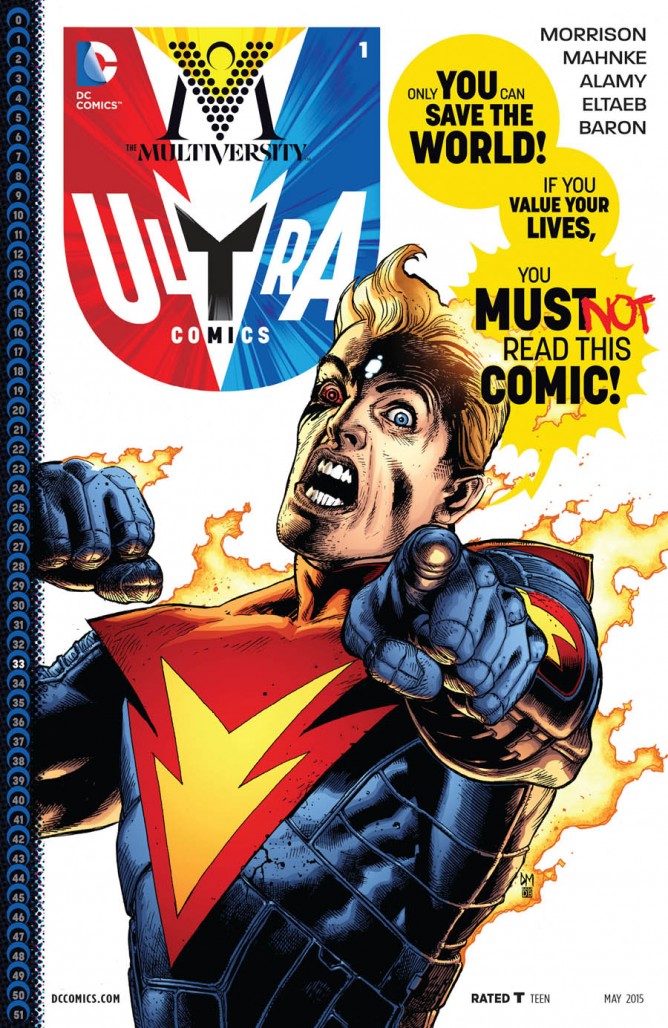
Writer:
Grant Morrison
Penciller:
Doug Mahnke
Inkers:
Christian Alamy
Mark Irwin
Keith Champagne
Jaime Mendoza
Colorists:
Gabe Eltaeb
David Baron
Comics aren’t meant to make readers feel guilty, but The Multiversity: Ultra Comics #1 paints the fan as the individual leading the protagonist to his ultimate fate. This is it – the haunted story teased since the first installment of Author Grant Morrison’s magnum Multiversity opus. The Multiversity as it stands is my favorite ongoing series from superhero publisher DC, it’s something that’s hard to believe anyone at the Big Two could even think about publishing. Morrison has been circling a sphere of comics self awareness with titles like Animal Man for several years now, and this feels like the natural progression of all those titles. Even though the writer continues to discover new things about self reflexive superheroes, he never feels like he’s repeating himself in this work. The ideas of the Psycho Pirate and Animal Man being erased from continuity is far different from than the mechanically engineered Ultra Comics presented in this work.
Standing on it’s own merits devoid of what came before with the series, is this book good?
Yes. The story can simply be read without that context via the playful opening from Morrison and the exceptional Doug Mahnke (who’s pencils have been sorely absent from Green Lantern.) Nearly every idea within this saga is a reintroduced story beat hatched from the DC vault. Still, this hero (Ultra Comics) emerged from pretty obscure roots and builds on nearly everything that Morrison has done with the DC Universe. There is even a reference to Final Crisis directly in this title showing that Morrison takes this absurdist pillar of the DC landscape that he has built extremely seriously.
The first thing that catches my eye about The Multiversity: Ultra Comics #1 is the Doug Mahnke cover. The piece is elegantly designed yet filled with utter madness reflecting some of the best covers from tales long ago. The text reading “YOU MUST NOT READ THIS COMIC,” should be the first clue that this is one of the most subversive and enthralling DC books you’re going to find this side of Convergence. What follows this is stirring image complete with a warning from Ultra Comics (our protagonist) to not finish this issue for the sake of his own very life. The storytelling stakes are set in this issue, and if we the reader choose to continue reading we’re to believe that the very fate of Ultra Comics has been decided. That’s a lot to take in over the span of just one story, and my own personal guilt regarding what happens next led is my own fault.
The first issue of The Multiversity arguably mixed the most concepts and characters and introduced us to the primary threat featured in this story – it’s essential reading to anyone left scratching their heads with this issue. This can be read stand alone as mentioned earlier, but to enjoy this text to the fullest a background in Morrison DC’s work is ideal. Ultra Comics is a book was first introduced via the live dissection from a Monitor within that issue. As a result, don’t expect this comic to be an easy read without the context of the broader series. It’s tempting to say that the threat of this book will be capitalized on as the baddie for the full Multiversity event, but Morrison has trained readers not to look at his work with such a clear lens. The Gentry are not everything that caused the bleakness in Multiversity – as the Multiversity Guidebook clearly articulated.
Mahnke’s storytelling skills haven’t missed a beat. The artist perfectly captures the detailed linework and impossibly huge facial expressions that make this work something truly special. His haunting images are best utilized in the context of horror, which this series arguably falls under. The villains contained within this story are terrifying, silly, and then maddening all in the context of one issue. Mahnke is called upon to be a really versatile artist in this experience, and does a great job on the static rendition of Ultra Comics nobly glimpsing at the reader. Also called upon are several other small flashes of violence with an exploration into the brutality buried deep within superheroes. Christian Alamy, Mark Irwin, Keith Champagne, and Jamie Mendoza bring this issue to a total of four inkers in this oversized. There are the occasional moments of inconsistency here, but overall this is some admirable work from the four mostly blending into each other and not detracting from the reader experience too much. The important part of the art in this issue is that Mahnke was allowed to draw a riveting horror comic.
There are so many different ideas crammed into this one piece of writing. The self reflexive asides kept the plot from becoming too complicated or too pedestrian. The buffer of Ultra Comics explaining his bizarre inner thoughts to the reader perfectly bring casual fans into the strange world of the title. There are so many different ways in which the story engages with readers, whether it be through Ultra Comics speech patterns, inner thoughts, dialogue trees, word balloons, and even meta-commentary within the context of the work itself.
To say much more about this story would spoil the delightful surprises waiting inside for readers to engage with. The Multiversity: Ultra Comics #1 is the only comic that ever melted off my face and left me in charge of the fate of my new favorite superhero.
I’m sorry Ultra Comics.
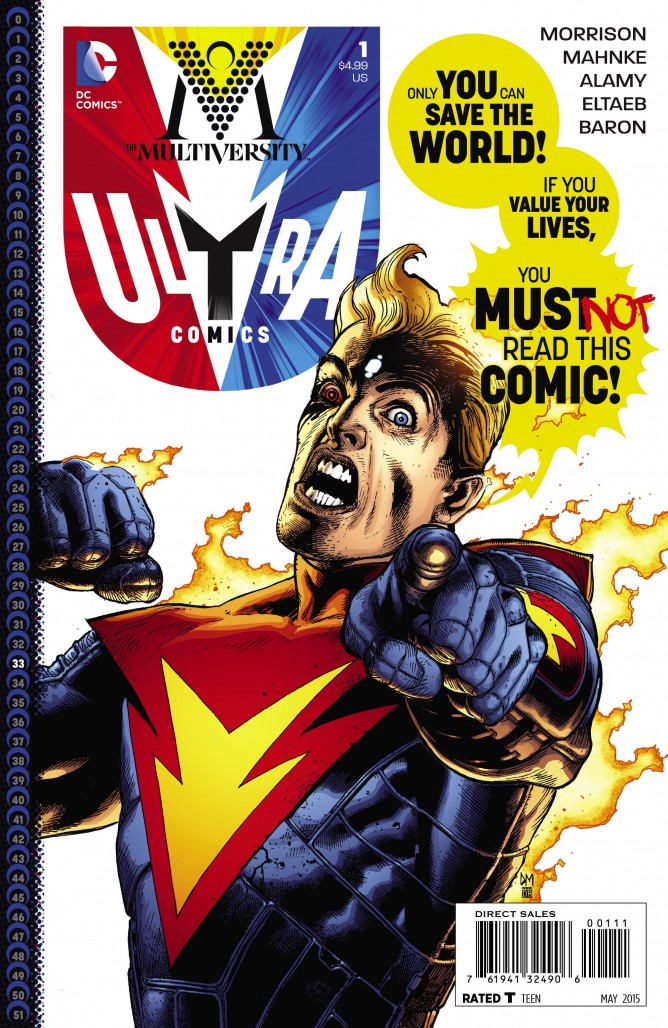
Via Paste Magazine, who also scored a great interview with Grant Morrison about the eighth chapter of his critically acclaimed The Multiversity, here is a five page preview of this week’s reunion between Morrison and his Superman Beyond collaborators Doug Mahnke and Christian Alamy: The Multiversity: Ultra Comics #1
Given that Superman Beyond is one of my favorite Morrison comics ever, it’s no surprise that I’m looking forward to just what this dreaded comic, that’s appeared in the majority of The Multiversity‘s previous chapters as a corrupting object, will offer.
If my eyes turn red and I start attacking all of my loved ones, you’ll know who to blame.
As an additional note, when speaking with Paste at the above link, Morrison made mention of the team’s biggest influence for the new issue:
One more thing is that Ultra Comics was inspired by the 1970s head comics. I don’t know if you’ve ever read Jim Starlin’s Warlock or Captain Marvel. I grew up on that. Back in the day, people like Starlin would come back from Vietnam and did these fantastic allegorical kind of Pilgrim’s Progress-style superhero comics. So I think Ultra Comics was my and Doug Mahnke’s attempt to almost create one of those cosmic comics of the ‘70s. Everything is allegorical. Everything is a metaphor. Everything is some psychological state. I will mention that, because those guys were a big inspiration for this particular issue.
THE MULTIVERSITY: ULTRA COMICS #1
Written by GRANT MORRISON
Art by DOUG MAHNKE and CHRISTIAN ALAMY
Cover by DOUG MAHNKE
1:10 B&W Variant cover by DOUG MAHNKE
1:25 Variant cover by DUNCAN ROULEAU
1:50 Variant cover by YANICK PAQUETTE
1:100 Variant cover by GRANT MORRISON
On sale MARCH 25 • 48 pg, FC, $4.99 US • RATED T
The penultimate chapter of the greatest adventure in DC’s history is here!
The acclaimed FINAL CRISIS team of Grant Morrison and Doug Mahnke reunite for a story so big it could only take place in the real world – that’s right, Earth-33 is back!
With the Multiverse under attack, a team of scientists create one final savior to take on the otherworldly threat…and its name is Ultra Comics! Literally held in your hands, one being will attempt to halt the annihilation of creation – and you, the reader, will have a front-row seat as you become an integral part of the resistance!
It’s another exciting, experimental story told by two of today’s top creators! You won’t want to miss this exciting issue which acts as chapter eight of THE MULTIVERSITY storyline.
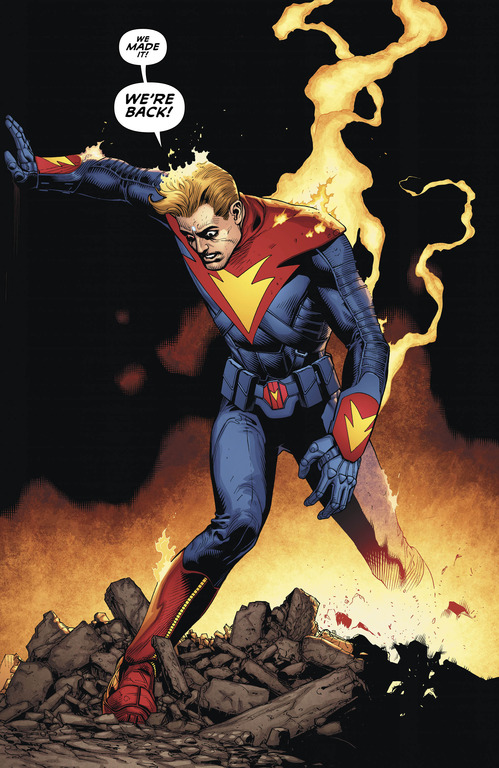
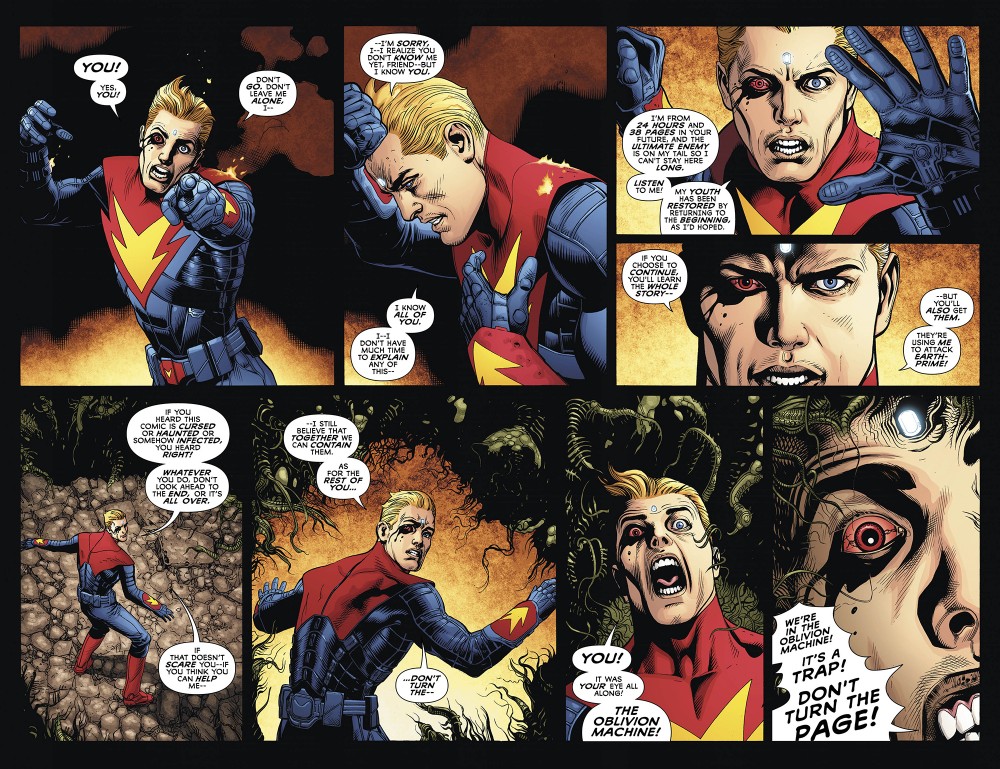
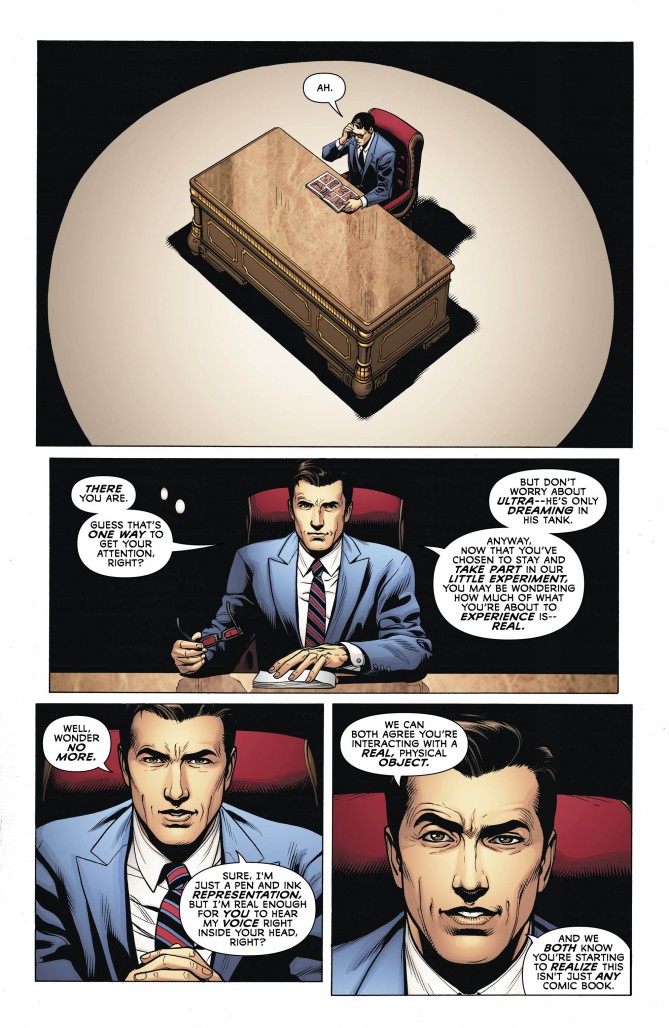
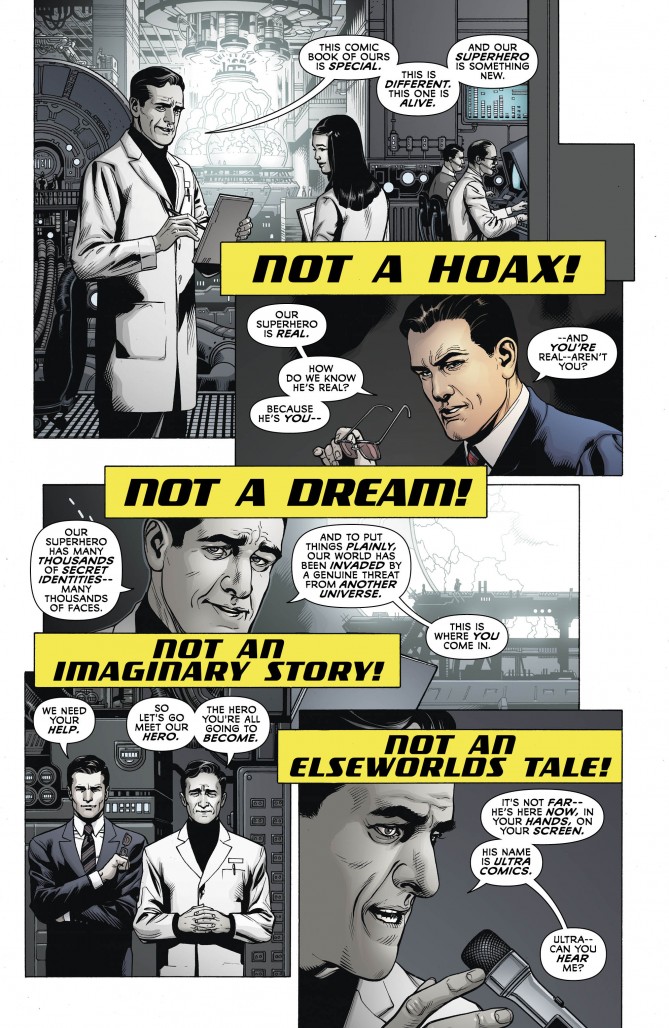
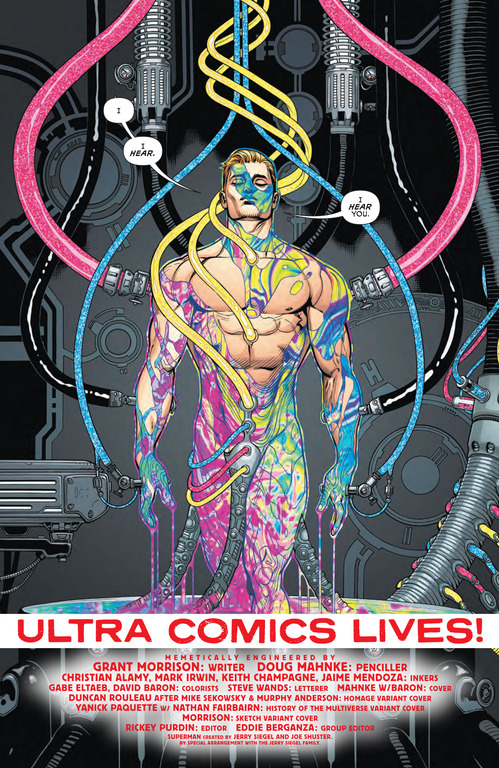
A panel on Friday, March 29th, the first day of programming at WonderCon brought together a rather iconic cast to discuss “iconic characters” and what keeps a character “true” to their origins over long periods of time. Mark Waid opened as moderator by pointing out that the table full of seasoned pros had more than 125 years of comics experience between them and most had worked on longterm characters and newer creations alike. The essential question posed by Waid was how to “vault” characters “into the 21st century without losing what keeps them special”. The question seemed particularly pertinent to Waid, whose ongoing work on DAREDEVIL has evoked critical acclaim. Waid asked his panellists how they handle the “core elements of characters” to face this challenge.
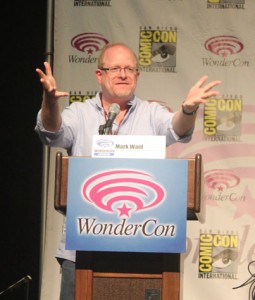 J. M. De Matteis introduced an image that stayed with the panellists as a reference point for discussion. He felt that creators handling long-lived characters work “within a cage”, so they can’t “go wide” with the character in term of change, but they can “go deep” in terms of making new discoveries. For De Matteis, personally, it’s all about the “Big Why” of characters, figuring out what makes them tick. He prefers working with super-villains to pose questions about the formative impact of their past histories because there’s “always a little corner of the psyche to dig into”. Ann Nocenti, however, in her recent work with Catwoman found that “her archetype was pretty clear” as a troubled kid originally, “on the streets” originally, and moving through “foster homes”. Her intuitive approach is to “play with a character and see what feels right” and she doesn’t mind the fact that later creators will do the same with long-term characters. It’s “like treading water”, she said, “You give a sense of constant, dynamic action, but you’re really not moving far”, and she expects later creators to be under the same constraint.
J. M. De Matteis introduced an image that stayed with the panellists as a reference point for discussion. He felt that creators handling long-lived characters work “within a cage”, so they can’t “go wide” with the character in term of change, but they can “go deep” in terms of making new discoveries. For De Matteis, personally, it’s all about the “Big Why” of characters, figuring out what makes them tick. He prefers working with super-villains to pose questions about the formative impact of their past histories because there’s “always a little corner of the psyche to dig into”. Ann Nocenti, however, in her recent work with Catwoman found that “her archetype was pretty clear” as a troubled kid originally, “on the streets” originally, and moving through “foster homes”. Her intuitive approach is to “play with a character and see what feels right” and she doesn’t mind the fact that later creators will do the same with long-term characters. It’s “like treading water”, she said, “You give a sense of constant, dynamic action, but you’re really not moving far”, and she expects later creators to be under the same constraint.
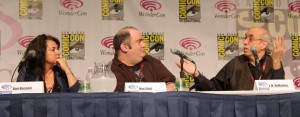 Doug Mahnke’s challenges, as an artist working on long-term heroes, is rather specific, handling costumes and their overtones. He observed that heroes, even today, often don’t look “contemporary” because their appearance has become iconic and we no longer question the anachronism, like Superman’s “underwear outside his pants”. Other features like capes and boots, Mahnke said, “made sense at the time” they were created based on a “swashbuckling” influence. In fact, he explained, an artist’s job is to “bring out the majesty in the character. It doesn’t matter so much what they’re wearing”, but you can use costume as a “tool” to use to your advantage.
Doug Mahnke’s challenges, as an artist working on long-term heroes, is rather specific, handling costumes and their overtones. He observed that heroes, even today, often don’t look “contemporary” because their appearance has become iconic and we no longer question the anachronism, like Superman’s “underwear outside his pants”. Other features like capes and boots, Mahnke said, “made sense at the time” they were created based on a “swashbuckling” influence. In fact, he explained, an artist’s job is to “bring out the majesty in the character. It doesn’t matter so much what they’re wearing”, but you can use costume as a “tool” to use to your advantage.
 Several of the panellists then commented on the fact that objectively, some of the nomenclature and costumes of characters created decades ago would seem “stupid” now. Nocenti’s example was a resurrection of a minor character, Zebra Man who was “visually fantastic” but the name and concept bizarre. Slott felt that once an icon is an icon, “the fact that it’s an icon gives it weight”, preventing further critique from readers. Even Waid’s considered opinion was that “Green Lantern” is a “stupid name for a character, but after 75 years”, it has “gravitas”.
Several of the panellists then commented on the fact that objectively, some of the nomenclature and costumes of characters created decades ago would seem “stupid” now. Nocenti’s example was a resurrection of a minor character, Zebra Man who was “visually fantastic” but the name and concept bizarre. Slott felt that once an icon is an icon, “the fact that it’s an icon gives it weight”, preventing further critique from readers. Even Waid’s considered opinion was that “Green Lantern” is a “stupid name for a character, but after 75 years”, it has “gravitas”.
 The panel then tackled the question of when and how exactly a character becomes officially iconic, and they set the bar high on awarding this status. De Matteis opined that “nothing about the character idea makes it iconic. It’s the execution”, and not every character reaches this status despite reasonably strong storytelling behind them. Dan Slott interjected that it only takes “one writer and one artist to do it”, like Frank Miller on DAREDEVIL. The discussion often drifted into slap-stick commentary on the more absurd aspects of superhero lore like the possession of a super vehicle as an icon accoutrement. Nocenti provided the little known detail that Cat Woman’s car is known as a “Catillac”. Slott confessed to proposing in a “meeting with real adults” that Superman’s car should be known as “Superman’s Ford Taurus of Solitude” with disasterous results.
The panel then tackled the question of when and how exactly a character becomes officially iconic, and they set the bar high on awarding this status. De Matteis opined that “nothing about the character idea makes it iconic. It’s the execution”, and not every character reaches this status despite reasonably strong storytelling behind them. Dan Slott interjected that it only takes “one writer and one artist to do it”, like Frank Miller on DAREDEVIL. The discussion often drifted into slap-stick commentary on the more absurd aspects of superhero lore like the possession of a super vehicle as an icon accoutrement. Nocenti provided the little known detail that Cat Woman’s car is known as a “Catillac”. Slott confessed to proposing in a “meeting with real adults” that Superman’s car should be known as “Superman’s Ford Taurus of Solitude” with disasterous results.
Waid observed that some characters are iconic in pop culture without necessarily being long-lived, like Woody Woodpecker, who’s highly recognizable, but not a currently active character. Waid commented that the tendency toward merchandizing may encourage the slow-down or freeze of new developments in a character since “every character becomes a beach towel” in the end. The entire panel segued into a long and fairly serious discussion of Wonder Woman as a character and why she has, or has not, lived up to her iconic status in terms of actual comic storytelling.

Most felt, like De Matteis, that Wonder Woman comics have not always been “all that good”, nevertheless the character definitely qualifies as “iconic”. Waid had a fairly idiosyncratic theory behind why this is the case. He observed that there was a strong “sexual element” to the “first 10 years of the strip” that was later removed to render the character more “plain vanilla”, and that now, lacking that “x-factor of sexuality”, stories fail to live up to the early days (an issue, he said, he frequently discusses with Grant Morrison). Slott disagreed pointedly with Waid’s assessment. He instead blames the lack of verve in Wonder Woman comics to the fact that comics are essentially a “make dominated industry” that has not explored the “many angles of the character” sufficiently. Slott still feels that if the right team is put together, the stories can rise to iconic status again, without recourse to the “weird quirky bits”. His choice of phrase caused plenty of giggling among the panellists.
This led Waid to ask his panel how they decide what elements are most essential to a character, what continues to translate, and what can be left behind. De Matteis advised to “always approach the characters psychologically and emotionally” and not worry too much about the “other stuff”, and sometimes that psychological appeal can be found in lesser known characters. Nocenti commented that her current work on KATANA based on the strange but intriguing concept of a “girl with a sword” produced “good potential” for developing “obsessional love triangle” elements between herself, her murdered husband, and his murdering brother.“The less iconic a character, the more fun you can have!”, she enthused.
Slott agreed with Nocenti on this idea, up to a point. When you’re handling an iconic character, readers lose the fear that their reckless lifestyles will do them in, whereas if a character is “unknown”, “Everyone is worried”, wondering if they will survive from issue to issue. Slott and Nocenti shared an interesting moment of commiseration, albeit brief, about their mutual killing off of Spider-based characters, and the emotional reaction of fans. “Screw letters from emotional fans”, Slott concluded, laughing, but Waid intervened by informing the audience that he’s sure Slott “weeps himself to sleep at night with 6 year olds’ fan mail” over the death of Spider-Man .
 The panellists didn’t always find their subject matter easy to decipher, nor did they feel that there’s always an easy answer for why some characters “click” as icons and some don’t. Batman, particularly, has a mysteriously successful dynamic, they said. But some things do change. Waid observed that he “couldn’t have imagined a world where I walked down the street and everyone knew who Tony Stark was” until after the Iron Man films had been made. Waid suggested that iconic status for characters might be measured in the number of imitators who have sprung up. De Matteis returned to his general position that archetypal patterns determine iconic status, however. Slott provided examples, stating that Superman is like Hercules, Batman a being on a vengeance-quest, and Tony Stark is, too, iconic in formula, as a combination of “Man and Machine”, an icon that the world is ripe for right now.
The panellists didn’t always find their subject matter easy to decipher, nor did they feel that there’s always an easy answer for why some characters “click” as icons and some don’t. Batman, particularly, has a mysteriously successful dynamic, they said. But some things do change. Waid observed that he “couldn’t have imagined a world where I walked down the street and everyone knew who Tony Stark was” until after the Iron Man films had been made. Waid suggested that iconic status for characters might be measured in the number of imitators who have sprung up. De Matteis returned to his general position that archetypal patterns determine iconic status, however. Slott provided examples, stating that Superman is like Hercules, Batman a being on a vengeance-quest, and Tony Stark is, too, iconic in formula, as a combination of “Man and Machine”, an icon that the world is ripe for right now.
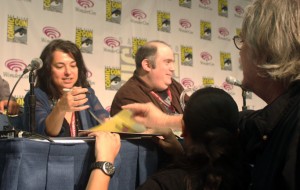 The panellists’ parting thoughts during the Q and A period focused on an interesting point made from the audience about the superhero/villain ratio. With so many more supervillains than superheroes in comics, “recycling” them is the norm, but at what point do they become “stale” and need to be retired, at least for awhile? De Matteis was firm about the roles of the artist and writers, insisting that there are “no stale characters but stale interpretations of characters” and that good work will prevent this problem. “Every character is great if you did into them in the right way”, he said. Waid’s closing example to support De Matteis’ point was that “20-25 years ago, no one would have thought that GREEN ARROW would become 2 times the best selling DC book, and then get his own TV show”. His bottom line: “If you dig deep enough you can find something that resonates”, and that’s the key to creating an icon, something that may not happen overnight.
The panellists’ parting thoughts during the Q and A period focused on an interesting point made from the audience about the superhero/villain ratio. With so many more supervillains than superheroes in comics, “recycling” them is the norm, but at what point do they become “stale” and need to be retired, at least for awhile? De Matteis was firm about the roles of the artist and writers, insisting that there are “no stale characters but stale interpretations of characters” and that good work will prevent this problem. “Every character is great if you did into them in the right way”, he said. Waid’s closing example to support De Matteis’ point was that “20-25 years ago, no one would have thought that GREEN ARROW would become 2 times the best selling DC book, and then get his own TV show”. His bottom line: “If you dig deep enough you can find something that resonates”, and that’s the key to creating an icon, something that may not happen overnight.
Photo Credits: All photos in this article were taken by semi-professional photographer and pop culture scholar Michele Brittany. She’s an avid photographer of pop culture events. You can learn more about her photography and pop culture scholarship here.
Hannah Means-Shannon writes and blogs about comics for TRIP CITY and Sequart.org and is currently working on books about Neil Gaiman and Alan Moore for Sequart. She is @hannahmenzies on Twitter and hannahmenziesblog on WordPress.
TweetThis week saw the release of Green Lantern #16 by Geoff Johns and Doug Mahnke, as well as Green Lantern Corps #16, by Peter Tomasi and Fernando Pasarin. The Green Lantern books are some of DC’s most popular, but recently seem to have fallen out of the spotlight, off doing their own thing while the [...]
Hiya out their in Blog-o-Land. It's the "Strange Ninja Librarian With No Name." formerly known as "Ninja Librarian Bill" and soon to be....... Well here is some more review stuff. Enjoy!!!!!
Green Lantern Volume1: Sinestro by Geoff Johns and Doug Mahnke - Okay I know some of you remember my comment about not liking DC's direction with The New 52, but Green Lantern for the most part seems unaffected except for this GN being labeled Volume 1. I missed event's leading up to this GN (yea I have had to give up comics for awhile due to an incredibly shrinking wallet) but Hal Jordan is no longer a Green Lantern having been given the boot by The Guardians of the Galaxy on OA. Sinestro is forced back into the Green Lantern Corps, but as we all know a tiger cannot change his stripes. Sinestro quickly finds himself, much to his chagrin, in deep trouble. His home world, Korugar, has been taken over by the former Corps he lead "The Sinestro Corps." He knows he needs help so he recruits one of the only former Green Lantern's he ever respected, Hal Jordan. Hal is happy to be free of the Green Lantern mantle and he joins Sinestro extremely reluctantly after Sinestro forges him a ring from his own. Together they take on The Sinestro Corps although things do not go exactly according to plan. Read it to see what I mean. Johns and Mahnke but together a pretty sweet story. Recommended for ages 12 and up!!!!!

Until next time all, peace,
Bill


















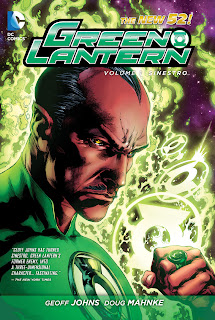

Grant Morrison has outdone himself with comics-about-other-comics here. This series has been so self-referential and obfuscatory that I have no idea who it was intended to please, besides G-Mo.
It definitely pleased me! But then again, I think Final Crisis is the best event comic ever made…so…grain of salt, I guess?
This was an amazing book, but I take issue with your citing of 1994’s Ultraverse. Ultraverse was an indy line of superhero comics, later bought by Marvel. You may actually be thinking of Grant Morrison’s concept of Hypertime (1999), which was the meta-continuity of all comics.
I would also like to point out that, following the theme of Multiversity where each issue is set on a different “classic DC-Earth” (Earth 1, 2, X, S, etc), this one is set on Earth Prime. Earth Prime is “our” Earth, where there are no superheroes and all the DC comics are, really, just comics that we read. Eventually, Earth Prime was written to have one superhero: Ultra. Right there is yet one more layer of comics-love that Morrison writes into this issue. It is also one more reason this issue is pretty amazing stuff.
All of Multiversity makes me think, “Oh, here’s why I used to love DC comics.”
Why do people who clearly don’t care for Grant Morrison’s work keep reading Grant Morrison’s work?
I read this, because I DO care for Grant Morrison’s work, and I loved it. I don’t think it reaches the heights of the “Pax Americana” and “Thunderworld” chapters, but it’s a great installment in Morrison’s ongoing meditation on superhero comics, and Doug Mahnke’s art is fantastic.
I think Ultra Comics is just as strong as the Pax Americana and Thunderworld installments, but it’s an apples and orange thing. They’re all really different, telling different kinds of stories. But equally successful. Ultra Comics was definitely successful in giving me the creeps! Not since the Bulletproof Coffin have I read a superhero comic so saturated in wrong-ness…the whole thing unfolded like a nightmare or a bad trip.
The big bad is an EGG?!
I like the work of Grant Morrison
This entire series has been a treat, and Ultra Comics was no exception. I wasn’t quite sure what to expect from it even with how it has been hovering in the background for the entire series so far, and it was great. All of the little Easter-eggs for the long-time DC fans were a trip, but the story itself was just great. I think I read the issue 6 times that first night – nothing else got read on Wednesday because I was just picking apart Ultra Comics and mulling it over. It is easily the most Grant Morrison comic Grant Morrison has ever written (to the point where I’m pretty sure he was making fun of himself and some of his own tics in it).
I’m curious to see how he ends it all in Multiversity #2, given that at this point it feels pretty much like he’s done saying what he wants to say. But then that’s Morrison’s writing in general – the journey through the story is almost always better than his endings.